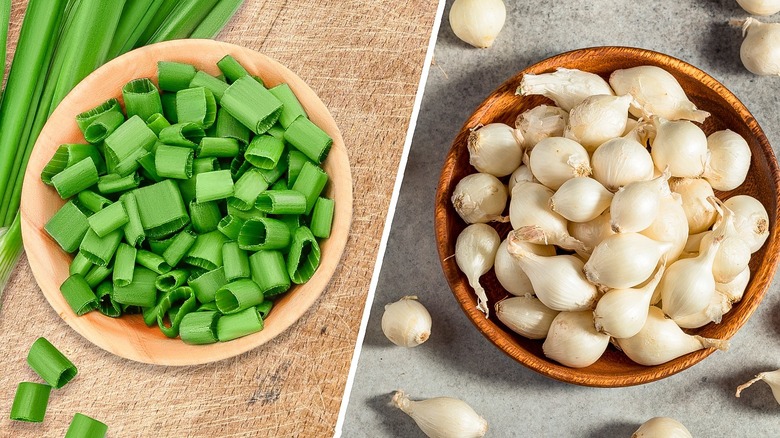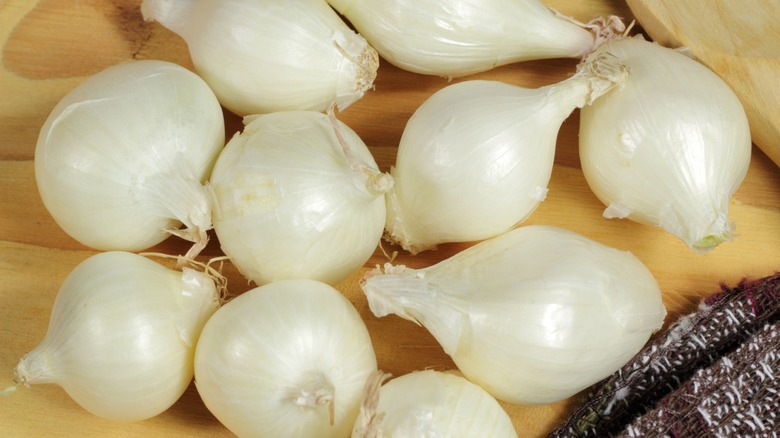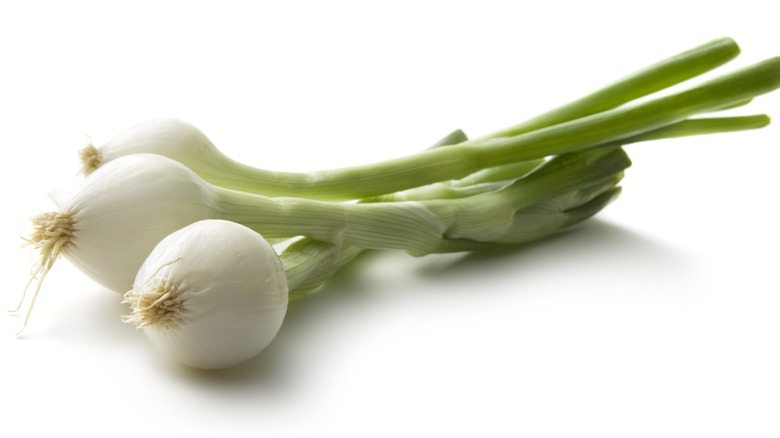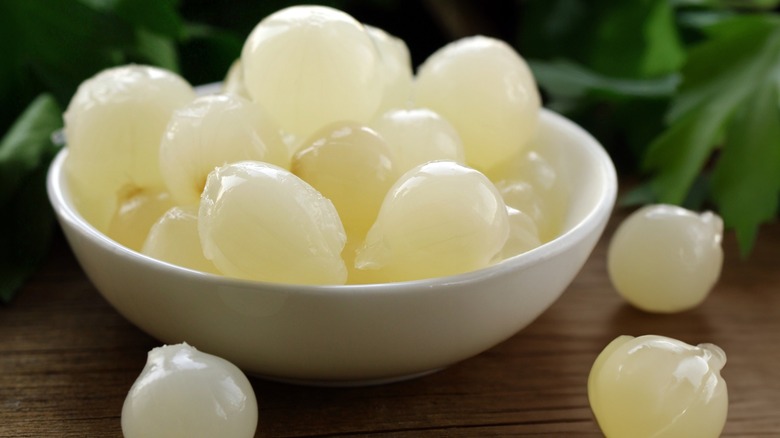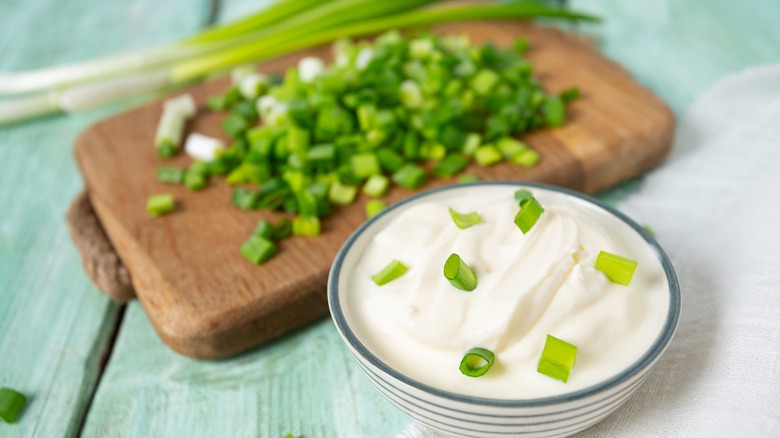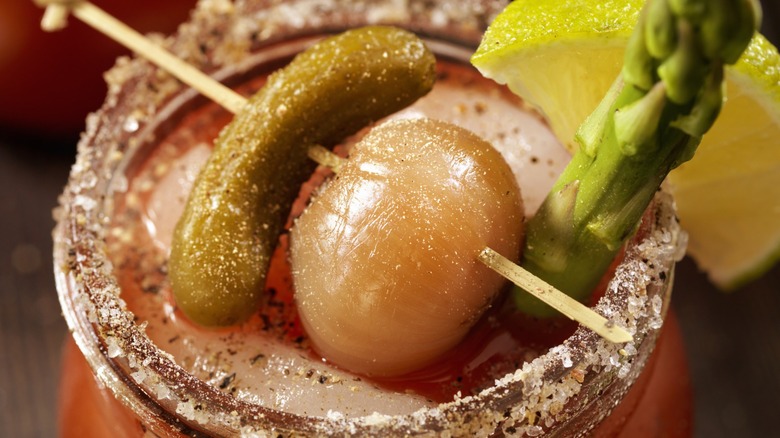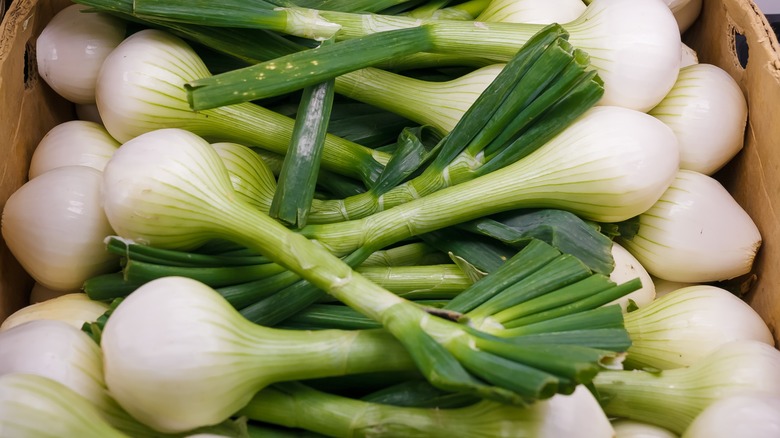Pearl Vs Spring Onions: What's The Difference?
No kitchen would be complete without onions. Rich in glutamates, they add so much flavor to food and different cooking techniques can reveal the various dimensions of their natural flavor. For example, sautéing an onion for a quick minute removes its acridity and enhances its umami flavor. Meanwhile, cooking it until it turns brown brings out the fullness of its sweetness; just follow the expert tip of being patient and giving an onion time to caramelize in the pan.
Chopping an onion up and adding it raw to vinegar releases its acidity while also infusing the solution with a sweet undertone. Aside from their transformative quality, onions also enhance the flavor of other ingredients and add a mouth-watering aroma and a crunchy texture to a dish. You can discover the depth of onion's versatility further by trying out the root vegetable's many available types.
Beyond the red, white, and yellow ones you see often in the market, explore other onion varieties to elevate your dishes, starting from prep until the addition of last-minute garnishes. Spring onions and pearl onions are two onion types you can use more often. Smaller than the other kinds of onions mentioned, their respective unique characteristics make them more applicable to certain cooking and prep methods.
What are pearl onions?
With a diameter of one inch at most, pearl onions aren't a separate variety of onions, per se. Rather, they're onions that have been cultivated so they don't grow into their full size. They are harvested around 90 days after getting planted, hence they're also referred to as baby onions or butter onions. You usually find white pearl onions in the market, although they're also available in red and gold.
These onions come covered in a paper-like parchment that can be removed simply by rubbing your thumb against the small bulbs. Underneath, however, is a thicker skin that must be removed before you can cook them. Blanching them for a couple of minutes and then giving them an ice bath immediately after is the best way to peel pearl onions. After letting them soak in iced water for a few minutes, cut off their roots. Then, you only need to squeeze the stem or the bulb to pop each onion out of its peel.
Pearl onions have a milder flavor than the regular full-sized varieties. They're sweeter, less pungent, and the flesh beneath the peel is nearly transparent. They're available to buy in the market all year round.
What are spring onions?
Like pearl onions, spring onions are crops that are harvested before they reach maturity. They're often mistaken for scallions even though there are distinct differences between the two. For one, spring onions are more mature than both scallions and green onions — two varieties that also tend to be mistaken for one another.
When looking for spring onions, look for the small, round bulbs at their base. This is a feature that immediately differentiates them from scallions. Depending on the spring onion variety, the bulbs can be white or red. Growing out of them are thick, tubular leaves that turn a darker green the farther they are from the bulb. Since they were kept from maturing, spring onions didn't develop the necessary amount of enzymes and sulfuric acid.
These compounds are responsible for producing propanethial S-oxide, which causes the stinging sensation you get in your eyes every time you chop regular onions and explains why onions make people cry. The lack of enzymes also makes the spring onions' bulbs sweeter and milder in taste. Their leaves, on the other hand, are pungent with a fresh, herbaceous flavor. Both parts can be eaten either raw or cooked.
Pearl onions can be cooked and added to dishes whole
Pearl onions can be cooked in a variety of ways: Glaze them in butter, sauté them for a few minutes until they start to brown, or steam them to let their natural flavor and crunch shine. Cook pearl onions using any of these methods for a tasty appetizer, side dish, or flavoring agent to stir-fry and pasta. If you want to bring out their sweetness further, you can grill them whole as part of a meat or vegetable kebab so their caramelized flavor adds a smoky sweetness to the dish.
You can also toss them with some olive oil, salt, and pepper, place them on a baking sheet, and then cook them in an oven that has been preheated to 400 degrees Fahrenheit for 25 minutes. Roasted pearl onions can be used as sweet and crunchy pizza toppings and served as an accompaniment to roasted or grilled meat. You can mash them with a food processor, too, and then mix them with grated cheese and mayonnaise to make a cheese and onion spread.
Since they get cooked pretty quickly, pearl onions can also be added whole as you simmer your soups and stews. Bake them with savory tarts and quiches and cook them with sugar to make onion jam. Basically, anything you can do with regular onions can be done with these smaller ones. Just expect a sweeter, milder taste to the dish.
Spring onions are wonderfully aromatic
You might be more familiar with seeing their leaves used as a garnish for ramen and other Asian dishes, but spring onions are just as versatile as pearl onions. There's definitely more to them than the pop of color they add to a plate. The leaves have a stronger flavor than the bulb, so you can chop them up to add a tasty bite to your homemade aioli or cheese dip. You can also use them to season a new wok to remove its metallic taste.
In one of her YouTube videos, "wok therapist" Grace Young advised stir-frying ginger and scallions in the wok, but spring onions can be used as a substitute for the latter since they're also flavorful and aromatic. Avoid slicing the leaves with a knife since they release moisture as they get cut, making the blade more prone to slipping. Instead, use kitchen scissors so they get cut into uniform pieces. You can also cut them lengthwise into inch-long strips and fry them in olive oil until they start to turn brown.
Enjoy the resulting crispy strips as a garnish, a snack, or a salad topping. Save the onion flavor-infused oil, too, for future cooking. As for the bulbs, cook them the same way you do regular onions. Chop them up to add to stir-fry and stews, caramelize them through roasting, grilling, or sautéing, or blitz them with other herbs and spices to make your favorite chutney.
Pearl onions retain their quality even when preserved
We've made the case for why frozen pearl onions should be a staple in your kitchen. They cut down on the time you'd spend on blanching and peeling them, plus, they taste as good as fresh ones. Another way of preserving pearl onions is by pickling them. Just as with regular onions, pickling gives pearl onions a delectable tang. You can add herbs and spices to the pickling solution as well so their flavor develops into something more complex, on top of the tasty combination of umami, sweetness, and acidity.
Serve pickled pearl onions as a refreshing side to fried dishes, add them to tacos, or use them to garnish rich stews to infuse some brightness into their flavor profile. Pickled pearl onions also make crunchy garnishes for cocktails. Their sweet and tangy taste is a perfect complement to drinks with a savory flavor, such as the Bloody Mary and the Gibson, although they also work well with fruity and tropical cocktails.
Moisture and heat degrade spring onions quickly
Despite their many possible uses in the kitchen, you could still find yourself having a bunch of spring onions left in the pantry. Unfortunately, they last for only two weeks at most even when properly stored, and, unlike pearl onions, there are limited ways to preserve them without losing their quality. In terms of short-term storage, spring onions can be left at room temperature for about two days before they start to wilt. Just make sure they're placed where they won't be exposed to direct sunlight.
Otherwise, keep them in a perforated container or wrap them in paper towels and then place them in a plastic bag to be stored in the fridge's crisper drawer; they'll be good for up to five days if kept this way. Don't wash them before stashing them away, however. Spring onions have a higher moisture content than regular onions, so any extra liquid can cause them to rot faster.
Another storage tip is to plop the spring onions in a jar of water, bulbs down, so they stay crispy for a week — a method similar to how cut flowers are kept fresh. Just remember to top off the water regularly and change it once it looks cloudy.
